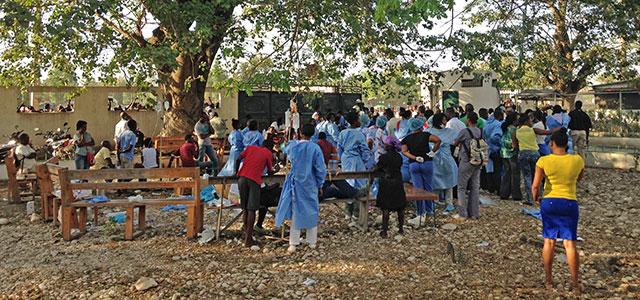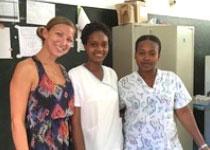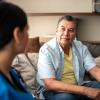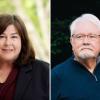
The makeshift triage unit set up outside the Sainte-Thérèse Hospital in Hinche, Haiti
Lessons from Haiti: Learning to Handle Mass Trauma
On a quiet March day in Hinche, Haiti (about 70 miles north of Port-au-Prince by car), Acute Care Pediatric Nurse Practitioner and UC San Francisco Global Health Nursing Fellow Sarah Meyer (MS ’15) was working at L’Hôpital Sainte-Thérèse, when a co-worker alerted her to something odd. A plume of black smoke had begun to snake into the sky above the center of town, about a mile from the hospital.
As Meyer would later learn, an 8,000-gallon tanker truck had hit a wall while pulling into a service station and began to leak its fuel load into a square where food vendors were cooking on outdoor grills with open flames. The fuel ignited, creating a line of fire that trailed back to the tanker. The resulting explosion and fire destroyed the service station, four homes and 22 vehicles, and killed seven people on the scene. Approximately 30 more were seriously injured, some with severe burns, and needed immediate medical attention. Many others sustained minor injuries.
Sirens and alarms from the United Nations (UN) base next to the hospital alerted Meyer and her colleagues that something serious had happened, and people began to trickle in with reports of the accident.
Reacting to Hinche’s First Mass-Casualty Incident
Sainte-Thérèse, the only acute care hospital in this rural area of Haiti’s Central Plateau, had never handled a mass-casualty incident. It was a low-resource facility, and while staff were accustomed to making do with the limited supplies on hand, most had never operated in a situation in which they had to treat a large number of patients with severe injuries. The hospital’s head surgeon was away at Port-au-Prince, so another surgeon took command of the operation, shutting down clinics and calling in all available staff for a quick meeting to prepare for the onslaught of seriously ill and injured patients. The nature of the accident meant that many would be suffering from burns and inhalation injuries, so staff talked about how to triage and treat them, and gathered the necessary supplies.
Within an hour, a maternity ward was cleared out and converted to a makeshift burn ward, with 15 beds for patients with the most severe injuries, just as people began to arrive carrying the injured on the backs of motos, the small motorcycles that serve as taxis in the area. (There are only a few ambulances serving the entire region, and no emergency medical technicians or firefighting services in Hinche, so patients would continue to come in on motos, on foot or carried in rescuers’ arms.)
Amidst Chaos, Triaging the Wounded
Meyer, who was in Hinche serving as one of UCSF’s global health nursing fellows educating local nurses, realized that triage was going to be very different from her experiences working as a nurse and nurse practitioner in acute care and emergency settings in U.S. hospitals.
First, the hospital didn’t have the capacity to triage the wounded inside the facility, so a triage area was set up in the courtyard outside the hospital. “Not the most sterile environment, but you do what you can,” she says. They put benches in a circle and had patients sit and lie there, so staff could see them all quickly and easily, then called other health care facilities for help. The nearest were outpatient clinics, so they could supply only extra gauze and fluids in the immediate aftermath of the accident.
In the U.S., color-coded tags would be used to note patients’ acuity and priority level, and what treatments or medications they had received. In Hinche, there were no tags, so two staff members went around with pieces of paper, recording important information for each patient, which nurses and physicians could refer to when doing reassessments.
Teaching Nurses to Treat Burns
 Most of the injuries were burns or inhalation injuries, but the majority of the nurses had not treated these types of patients before. Meyer instructed them on using the Parkland formula for IV fluid resuscitation – an essential element in treating burn patients. The formula, which is part of the standard of care for burn victims in the U.S., multiplies the patient’s body weight by the total surface area burned to determine the amount and rate of fluids to give.
Most of the injuries were burns or inhalation injuries, but the majority of the nurses had not treated these types of patients before. Meyer instructed them on using the Parkland formula for IV fluid resuscitation – an essential element in treating burn patients. The formula, which is part of the standard of care for burn victims in the U.S., multiplies the patient’s body weight by the total surface area burned to determine the amount and rate of fluids to give.
There were no scales available, so patients’ weights had to be estimated. Meyer gave the nursing staff a quick-and-dirty way to estimate the burned surface area on a patient. “The easy way to remember is that each hand is one percent [of body area]. It works for both adults and children,” she says.
She also helped nurses learn to use clinical assessments to determine if a patient had a significant inhalation injury. In Hinche, nurses normally use basic (and often old or damaged) pulse oximeters to measure oxygen saturation. But pulse oximetry isn’t accurate for measuring oxygen levels in people with inhalation injuries, and laboratory results, which could provide more accurate information, can’t be delivered fast enough in Hinche to inform care immediately, so staff had no reliable way to determine if patients were getting enough oxygen. “We had to do a lot of clinical reasoning just by looking at patients,” Meyer says.
Meyer’s previous relationship as an educator for the nurses at Sainte-Thérèse was a boon in the stressful environment of mass trauma care. “In [Haitian] culture, you don’t question or interrupt authority, and it’s hard to ask a physician to repeat an instruction. I had a good relationship with the nurses, so they felt comfortable asking me a lot of questions,” she says. Also, she spoke Creole fairly fluently, thanks to previous stints working in Haiti and a concerted effort to improve her language skills prior to beginning her fellowship in 2015, so she did a lot of translating for foreign clinicians who didn’t speak the language.
Supply Shortages Add to the Challenge
In addition to a steep learning curve, nurses and other clinicians had to grapple with shortages of essential supplies, the most significant of which was not having enough supplemental oxygen. “We had large oxygen tanks that were delivered only once per week,” Meyer says. “If you’re running a big tank at 12 or 15 liters [per minute], which some of these patients need, you’re going to run out fast.”
When ambulances began to arrive from larger cities the day after the accident to transfer the sickest patients, many with inhalation injuries, to higher-resource hospitals in Mirebalais and Port-au-Prince, some weren’t equipped with oxygen – or not enough oxygen to make the long trip. Clinicians accompanying the patients had to make do with what the ambulances had on board, and hope that it would be enough. Meyer says that perhaps her most harrowing experience was accompanying a child with full-face burns during an ambulance transfer to the burn hospital in Port-au-Prince, a six-and-a-half-hour drive that day due to a bridge being out.
“It was traumatic for everyone,” she says. “I was nervous because I didn’t have enough oxygen to make the trip. Fortunately, he maintained his airway, because if he hadn’t, there wasn’t a lot I could do.”
Security and crowd control were other serious challenges. With the triage area in the courtyard, crowds of people – the injured, those searching for the injured and those who were simply curious – began to flow through the large gate, creating confusion. Fortunately, aid from the nearby UN base and from the Haitian police arrived shortly to help control crowds; nevertheless, it was difficult for clinicians to sort the injured from the noninjured, and to triage patients effectively. Haitian culture, says Meyer, encourages people to wait and to defer to social hierarchy, so many of those who were worst off said nothing.
In the end, Meyer believes Sainte-Thérèse staff acquitted themselves well. Only one patient died at the hospital, although she doesn’t know the status of the nine sickest patients, who were all transferred. Afterward, she and another nurse educator put together a grand rounds presentation and a series of educational lectures on burns for nurses.
Working in Haiti and the U.S.
 Sarah Meyer (left) with colleagues in Hinche Meyer completed her fellowship in Hinche this summer. Partners in Health, a nonprofit organization that brings medical care to underserved regions, which partnered with UCSF to create the global health nursing fellowship, invited her to work in its Mirebalais hospital as a nurse educator in acute care.
Sarah Meyer (left) with colleagues in Hinche Meyer completed her fellowship in Hinche this summer. Partners in Health, a nonprofit organization that brings medical care to underserved regions, which partnered with UCSF to create the global health nursing fellowship, invited her to work in its Mirebalais hospital as a nurse educator in acute care.
She is splitting her time in Haiti with another job as a pediatric nurse practitioner in the emergency department of Children’s Hospital Los Angeles. It’s an unusual setup, but Meyer relishes the challenge and variety.
Her work in Haiti brings value to her U.S. work, she says. “I’m learning a lot about diseases like malnutrition that we don’t think about much here, but do exist. Also, about cultural understanding. We have many different cultures here in California, and being able to understand how different people talk about things is important.”



